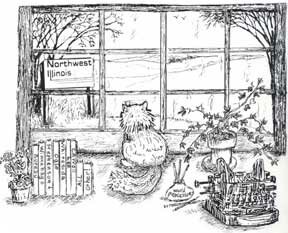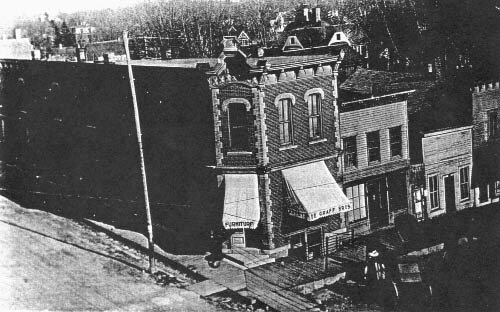
Discover rewarding casino experiences. 

Please Don't Quote Me Note the plank sidewalks and hitching rails for the horses. The “Paley Block” (now Schrader Realty) stands in all its brick glory while nestled against it are the modest wood frame buildings that once lined Lanark Broad Street, some moved from places such as Georgetown or Brookville. |
The first (left side) is Carl Schoen’s harness/leather shop. He came to Lanark in spring, 1862. The shop was still in business a hundred years later but is razed. Country Insurance is the light colored structure next, south, 105 South Broad, Rhett Coatney, proprietor. The two story building on the right was for a time called the “Cowell building,” then for more years, the “Teachout building.” School lessons were given here as well as other sites around town ... Probably a “subscription school.” It was torn down in the 1920’s to make way for the Rock Creek Township building where meetings were held and voting took place. It was called the “Comfort Station” for the public rest rooms conveniently housed there. It remains also. Joe Yeager’s corner is for sale or rent—none better adapted to care for buggies, autos, farm machinery.” Read the ad in the Lanark Gazette in December of 1915. Besides advertising a long-time business address there was a prophetic tone to the announcement. If ever there was an “adaptable” building it was that at east Carroll Street. However, it wasn’t always at that site. As a matter of fact it had had a long, variable history at Brookville and at two places on downtown Broad Street, beginning in the 1850’s at which time Brookville was the happenin’ place. Brookville had the usual stores and trades common to a small rural village plus there was a busy pottery and kiln, a nearby brick works that made pieces used in many local houses, some of which remain and, of course, Herb’s Mill that had had a couple different owners from an early time. The point had been a major stagecoach stop on the important Galena-Peoria Trail there in the hickory grove that had been a landmark. Shouldn’t’ one expect it to continue to grow to become a town of some size? But then the modern day arrived by rail and Brookville was omitted from the then way of village’s becoming towns, towns cities. The railroad. The Illinois Central came all the way upstate, missing Brookville by only a few miles but assisting Buffalo Grove into becoming Polo and Woosung developing only into a main line market. For a few years it didn’t seem to faze the old mill site but when another rail line was to run from Racine to the Mississippi across Carroll County to the west, that was it! Too much competition both borders. Handwriting was on the walls, so to speak, it took the form of the straight lines of the iron rails. Bankruptcies and fraud had slowed the progress of the rails’ arrival just as bad weather and quicksand might, but finally in 1860-61 the tracks from the northeast finally came in and two altogether new market-depots were initiated, Shannon and Lanark. This year, 2010, Shannon celebrates its Sesquicentennial. Watch the news for events. Lanark begins its anniversary next year, 2011. Joe Yeager who had a buggy shop in Brookville came to the prospective site of Lanark in June of 1861 to look over the possibilities. Perhaps there were a few piles of lumber stacked by what would be the track line with a couple hand-hacked stakes driven into the ground with a torn, ragged cloth tied to them marking the perimeters of the Grand Hotel the rail company was building. That was all, but the group liked the long sloping hill that climbed from the south to where the depot would rest in what was the center of Section five, Rock Creek Township. A winding, glittering creek lay to the north. Gentle hills described the landscape which was planted to wheat as far as the eye could see. Yeager opted to buy a lot on what would be the main street, west side, mid-block. $150.00 bought a commercial lot. Done. His purchase was two blocks south of where the depot would lay and where in the twentieth century an impressive Masonic Temple wold be built to its north side. But at that time no such pretensions would be thought of. In fact, quite the opposite. In November of 1861, Yeager jacked up his modest wood frame shop (and probably residence, too) and had it pulled/pushed across the intervening prairie. Necessity and thrift were the reasons for such moves. The town would be called Glasgow at first but had to be changed because there already was such in Illinois so it became Lanark for the shire where the bank that finally lent the money for the railroad to come through successfully. October had been chosen for the engine’s arrival date because the wheat had to be harvested before any other work could be done. When the date came there were two to three hundred filled wagons lined up at rail’s end waiting to be unloaded to go off to market possibly for transformation grain into bread for the Boys in Blue at camp or war front because the Civil War had begun spring, 1861, also. Now stakes could be set for streets and alleys; lots and plots. Due to the railroad, the town took off successfully from the start. Thus it was that there was a housing shortage and winter was drawing nie. Tents, genuine or makeshift, were put up. Some slept under a ceiling of stars in a rolled up blanket. Other buildings like Yeagers’ may have been dragged from Brookville but there is not even a mumbled aside to tell us that. The first mobile homes, it’s said, came from Georgetown, several in fact, that remain still as residence all these years later. The photo here of the “Paley Block” has nestled against it the humble false-front, wood frame buildings Broad Street was originally lined with. In numbers they may well have been moved in, too. They were adaptable. For some reason not yet discovered, Joe Yeager again moved the Brookville building but this time just across the street, the corner of Broad and East Locust, that in spring, 1882. Had he been offered a swell price for the west side lot? No prestigious edifice rose to justify the change ... Only another row of modest wood frame structures called simply the “Minnier building” for many years came about and then razed to make way in mid-twentieth century for the brick building there today, host originally to the post office and the manufacture of fabrications which occupies the entire building today. Perhaps, Yeager wanted the location, location, location so vital to success, a corner lot. He’d moved in spring of 1862 and ruled there for twenty years until the Paley Block took the spot in 1882. Joe Yeager’s buggy works became a fixture at the Corner. The whir of saw and drill echoed up the main avenue. Pounding of felloes into wheel rim resounded satisfyingly telling all that it was Business AS usual at Yeagers so all was right with the world. Although several years of Lanark Gazette files are missing, a few details were secured from extant issues of the Carroll County Herald where an ad read: “Full time buggy trimmer on hand at all times.” Apparently an amenity the public desired. Joseph Yeager was an active, concerned business man ... All committees knew of his energetic interests ... School board, city, etc., etc., etc. If the upper level of the carriage shop had served as residence, by 1868 it had become too cramped and a house must be built ... Up East Locust at the corner of High and Locust, caty-wampus across from the Methodist Church the upright north section was put up. Not until 1888 was the south wall added and which all remains today as 103 S. High. Meanwhile, Lanark increased in size and variety steadily. One year especially being a boom year, 1882, when brick blocks replaced wood frame ... Dates and names of builders were set in the elaborate Victorian trim of commercial structures such as in ‘82 with Heath; Hess next north added on, the Exchange Bank across the street, Shumway at the other end of the block, more. Jim Hallett’s brick works ran the kilns overtime in northwest Mt. Carroll to keep up ... 400,000 bricks at a burning, 120 cords of wood at bake time. No wonder he sued neighbor Dave Tipton because his “geese delighted in walking over the green (unbaked) brick, marring them.” He was awarded five dollars by the Justice of Peace for costs! Bricks stood in piles everywhere on Broad the year 1882. The “Paley Block” dominated the east side Broad Street as it rose brick by brick that year. Yeager’s Corner had become the Paley Block ever after! But who was Robert Paley? He was president of the National Bank, c. 1870’s, just north across the street, that’s who. He’d done the correct thing in 1879 when he’d signed on as a true Lanarkian when he began building a house in Stover’s Addition out east at the end of Locust (was it exclusive out there?). The acreage cost $450.00 and if recalled correctly, the house sum was $7,000.00, an exorbitant amount. It, too, remains, 639 E. Locust.
Did also Paley pay Yeager a healthy amount for his Corner lot so Paley, too, could build a brick on Broad? Something had urged Joe to move ... The third time for that venerable old wood, Joe wouldn’t be beyond making a profit and, besides, he was so well-known. Location, location, location was hardly a question anymore. He’d have a Corner lot, perhaps more space and could build a two-story roomy ramp on which to move the buggies down from the upper level like buggy shops out to. And, besides up on Carroll Street it was “Industrial Avenue” what with grain elevators, machinery warehouse, plumbers and windmill men, stockyards and more tradesmen whose music with the railroad made a harmony that the town, figuratively, at least, actually hummed! There’s be another Yeager’s Corner which since the demise of his shop has, indeed, become adaptable as the ad stated. It’s been just about every sort of shop since the buggy/carriage. It’s slow, ponderous move in 1882 plunked it down on Carroll Street. Read next week about the Brookville buildings subsequent history. As for the Paley Block, a larger basement was immediately dug for future tenants and to be the August design it became.
|




